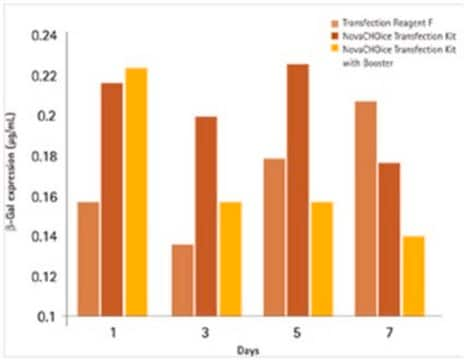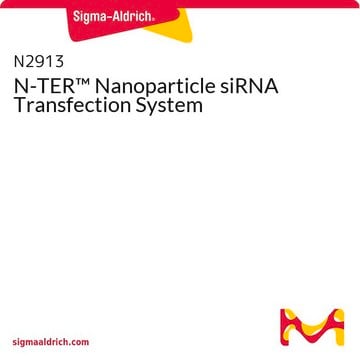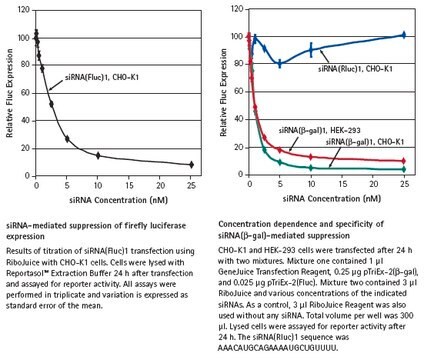L3287
Escort™ IV Transfection Reagent
Lipid reagent for transient and stable transfection of mammalian and insect cells.
Synonym(s):
Gene delivery
Sign Into View Organizational & Contract Pricing
All Photos(2)
About This Item
UNSPSC Code:
41106502
NACRES:
NA.25
Recommended Products
grade
for molecular biology
Quality Level
form
liquid (aqueous solution)
usage
1 mL sufficient for 160-500 transfections
concentration
1 mg/mL
technique(s)
transfection: suitable
storage temp.
2-8°C
Related Categories
General description
Escort™ IV is a unique formulation of a proprietary polycationic lipid and a neutral non-transfecting lipid. This liposome-forming compound is used for transfection of nucleic acids into a wide variety of eukaryotic cell types.
Application
Suitable for transient and stable transfection of nucleic acids into cultured eukaryotic cells. Use approximately 4-16 μL Escort™ IV and 2 μg DNA per 6 cm cell culture plate. Protocol optimization provides very efficient transfection. For a list of cells that have been successfully transfected using Escort™ IV, see the Transfection Reagent Selection Guide.
Features and Benefits
- Suitable for stable and transient transfection
- Optimized for a wide variety of cell lines
- Low toxicity
- Compatible with both serum and serum-free transfection protocols
- Ideal for Sf9, Sf21 and S2 insect cells
Components
Escort™ IV formulation:
1 mg/mL total lipid in water
Note the identity of the lipids used in Escort™ IV is confidential.
1 mg/mL total lipid in water
Note the identity of the lipids used in Escort™ IV is confidential.
Caution
Do not freeze.
Principle
A stable complex is formed when Escort™ IV is mixed with DNA in the absence of serum. The complexes are stable and can be directly added to the cell culture medium, where they fuse with the cell membrane, releasing the DNA into the cytoplasm. Note: complex formation is inhibited by serum, but once stable complexes have formed, the presence of serum is without consequence.
Legal Information
Escort is a trademark of Sigma-Aldrich Co. LLC
related product
Product No.
Description
Pricing
Storage Class Code
10 - Combustible liquids
WGK
WGK 3
Flash Point(F)
Not applicable
Flash Point(C)
Not applicable
Personal Protective Equipment
dust mask type N95 (US), Eyeshields, Gloves
Certificates of Analysis (COA)
Search for Certificates of Analysis (COA) by entering the products Lot/Batch Number. Lot and Batch Numbers can be found on a product’s label following the words ‘Lot’ or ‘Batch’.
Already Own This Product?
Find documentation for the products that you have recently purchased in the Document Library.
Customers Also Viewed
Melissa D Jordan et al.
Chemical senses, 34(5), 383-394 (2009-03-19)
Moths recognize a wide range of volatile compounds, which they use to locate mates, food sources, and oviposition sites. These compounds are recognized by odorant receptors (OR) located within the dendritic membrane of sensory neurons that extend into the lymph
Manveen K Gupta et al.
Antioxidants & redox signaling, 8(5-6), 1081-1093 (2006-06-15)
Cardiac myocytes, upon exposure to increasing doses of norepinephrine (NE), transit from hypertrophic to apoptotic phenotype. Since reactive oxygen species (ROS) generation is attributed to both phenomena, the authors tested whether an elevation in intracellular ROS level causes such transition.
Zev Bryant et al.
Proceedings of the National Academy of Sciences of the United States of America, 104(3), 772-777 (2006-12-22)
Myosin VI supports movement toward the (-) end of actin filaments, despite sharing extensive sequence and structural homology with (+)-end-directed myosins. A class-specific stretch of amino acids inserted between the converter domain and the lever arm was proposed to provide
Michael Povelones et al.
PLoS pathogens, 7(4), e1002023-e1002023 (2011-05-03)
Malaria threatens half the world's population and exacts a devastating human toll. The principal malaria vector in Africa, the mosquito Anopheles gambiae, encodes 24 members of a recently identified family of leucine-rich repeat proteins named LRIMs. Two members of this
Victoria J Hammond et al.
The Analyst, 133(1), 71-75 (2007-12-19)
Sol-gel nanoprobes, also known as Photonic Explorer for Bioanalysis with Biologically Localised Embedding (PEBBLE), capable of performing in-vitro intracellular monitoring of reactive oxygen species have been developed using a modified form of 5(6)-carboxyfluorescein diacetate. A sol-gel matrix was selected for
Our team of scientists has experience in all areas of research including Life Science, Material Science, Chemical Synthesis, Chromatography, Analytical and many others.
Contact Technical Service












